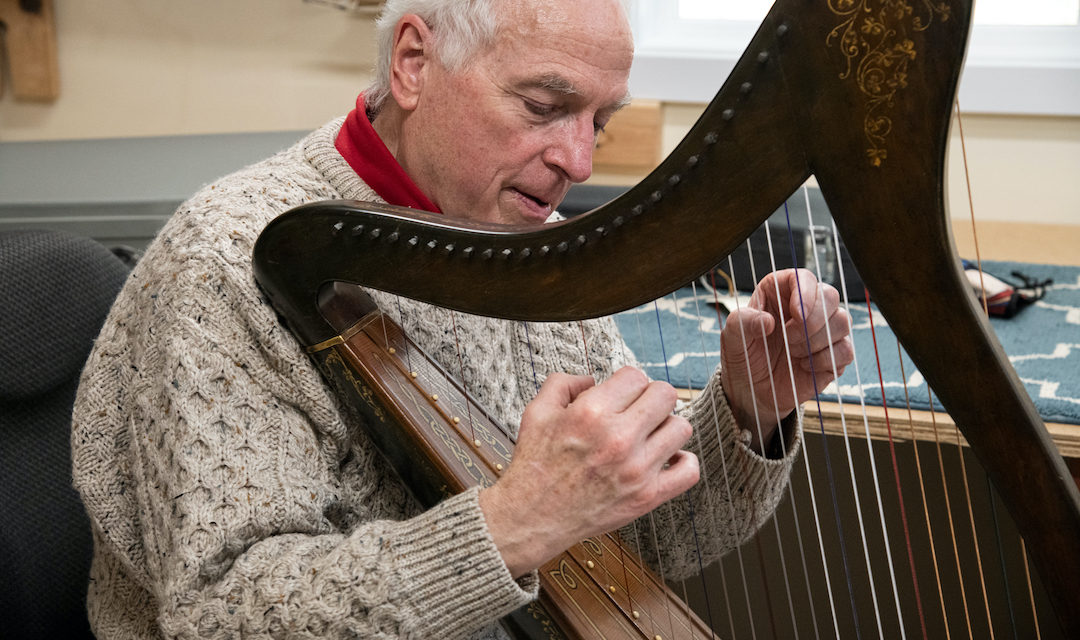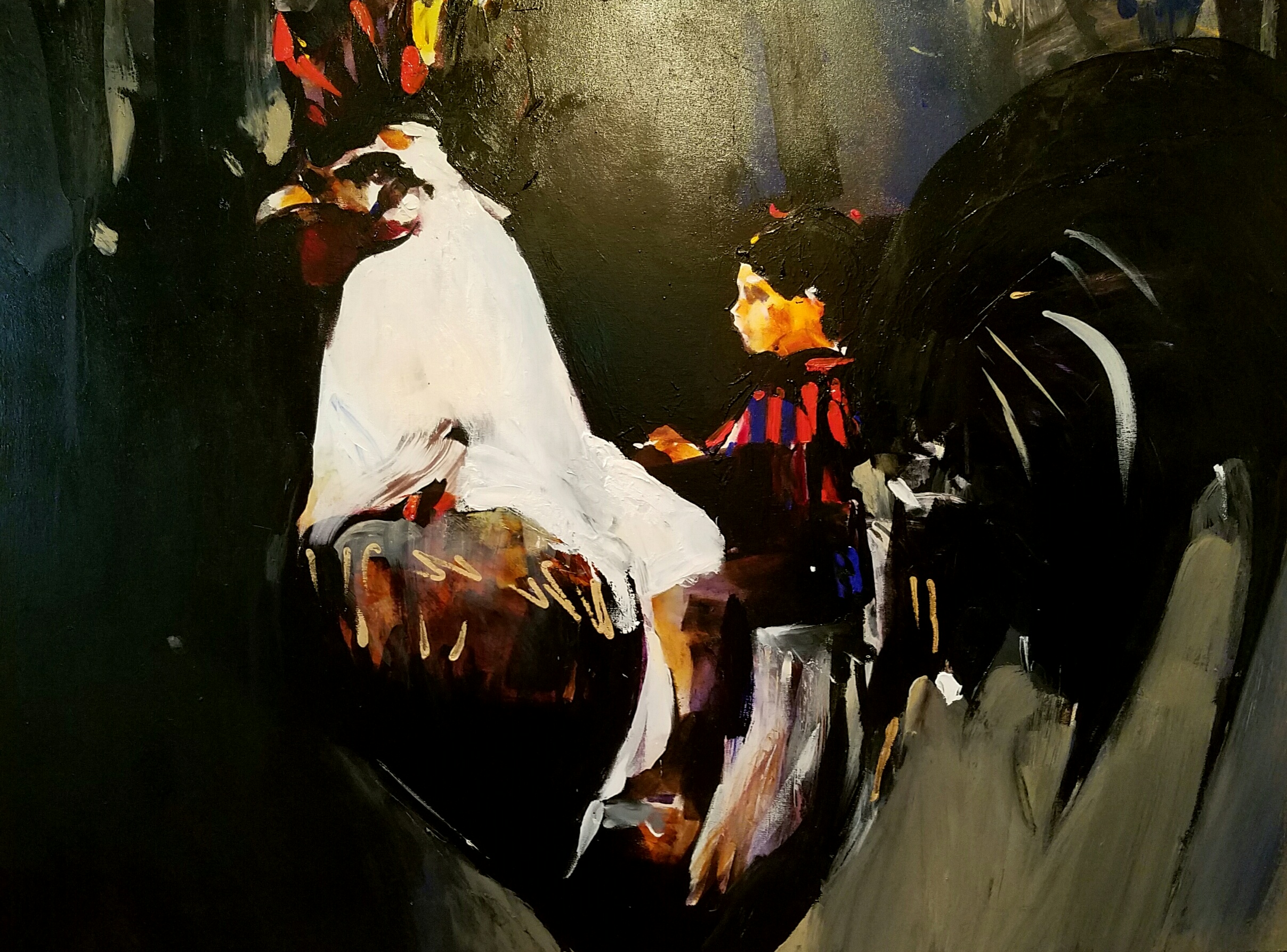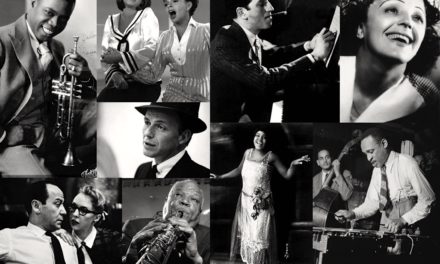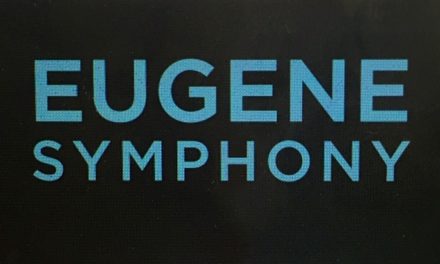(Above: Master instrument craftsman David Rivinus fingers the strings of a century-old, badly damaged harp after fully restoring it.)
By Jordan Essoe
YACHATS — A musical instrument restorer who has always been attracted to ambitious projects has come out of retirement to bring one more trounced instrument back to life. This time, it’s something he’d never worked on before.
Meet David Rivinus, a 72-year-old expert restorer and innovative luthier — the term for a maker of stringed instruments such as violins or guitars — who in the past who has invested as much as a year of intense, unpaid restoration work on a single project, returning an instrument found in crushed pieces to stunning, fully playable condition. He undertakes projects very few others in his field would because he doesn’t let the marketplace tell him what to do.
Musical instruments are susceptible objects. Wood shrinks. Glue weakens. Pins break. Wood-boring beetles infest and burrow. Neglect and human accidents are likely. Even oils or acidity from the very musicians’ hands that instruments are designed to be held by can be destructive to strings and varnish. As can bleach and hand sanitizer, for those musicians currently trying to maintain a Covid-free environment.
“Most fragile instruments don’t survive,” said Arain Sheets, curator of stringed instruments at the National Music Museum in South Dakota. “They wear out, they get lost, they get thrown out, they get replaced. And a lot of it has to do with that equation of how much it takes to fix something versus how much a new instrument costs — and is it worth it.”
The condition and cost of instruments matter, but violas, guitars, and flutes are more than just tools. The place they occupy in a musician’s life amounts to something significantly more sacred.
“There come moments when only music can fill that human, existential void that threatens to overwhelm us all,” Yachats musician Gretchen Armstrong said.
Against the terrible odds of history, a percentage of musical instruments survive. Bone and ivory flutes have been discovered that are older than 30,000 years — possibly as old as 60,000 years, if disputed claims about Neanderthal flutes prove to be true.
On the other end of the timeline, even the newest of instruments commonly need repair. You might need to replace a peg. Re-glue a fingerboard. Heat-treat a warped bow. These are simple fixes you can probably get done at a shop for less than a hundred bucks. Yet when you get into extensive restoration work for severe damage, the cost can quickly run into the thousands of dollars, or even tens of thousands. At that price, the instrument will likely not be worth enough money to justify the investment. These are the broken instruments that usually end up in the garbage.
But not always. Sometimes Rivinus intervenes.
As a craftsman, Rivinus is attracted to the challenge and pleasure of his labor. As a person who has spent a lifetime deeply devoted to all aspects of music, he is driven by a romantic sense of responsibility and stewardship. He keeps an eye on the expansive sweep of both the past and the future.
“These instruments are going to survive us,” said Rivinus. “I’m going to kick the bucket, and this thing is going to endure.”
The philosophy he has adopted takes a holistic long view. After working with hundreds of clients in the restoration business, he arrived at the idea that instruments cannot truly be owned. He observed that, in a philosophical sense, even if someone spends tens of thousands of dollars on an instrument, it’s doesn’t actually “belong” to them. Nor does it belong to any musicians that played the instrument before them. Or the ones that may come after. The instrument belongs to something greater than all of them. It belongs to history.
“You are its custodian for as long as you keep it or for as long as you live,” said Rivinus. “But you are basically just a blip on the radar screen of this instrument’s life.”
Rivinus’ restoration work focuses on instruments of the violin family. He was first introduced to the craft as a college student in Indianapolis, where he worked for a local violin maker. Though a member of his college chamber orchestra, Rivinus was a shy performer. He didn’t like being on stage. In contrast, he felt immediately at home in the maker’s workshop.
In Hollywood, California, he apprenticed under a famous violin restorer named Hans Weisshaar. Weisshaar had two international reputations. He was a brilliant restorer, and a really difficult person to work with. Rivinus studied at Weisshaar’s elbow for four years, from 1975-79, and as taxing as it was, he didn’t regret a single day.
“That is where I learned to do what I do,” said Rivinus. “He was extraordinary. No question about it.”
In the 1980s Rivinus ran his own shop with a partner in Glendale, California. By 1989 he was burned out by excessive work that offered minimal creative challenge and took a respite from the industry to farm in southern Vermont. During this time, he raised pigs, turkeys and geese, tapped maple trees, and – in his spare time – he invented an instrument design no one had ever thought of before.
He called it the Pellegrina, and this ergonomically compressed viola had an eye-catching torqued body that made Rivinus famous among players and collectors. The Pellegrina was constructed to offset some of the common musculoskeletal injuries professional viola players are likely to suffer.
“His violas were some of the few non-conventional models that have been fairly widely accepted by professional musicians,” Sheets said. “These ergonomic instruments were actually solving a problem that musicians had. And it helped them extend their careers.”
In 1998 Rivinus moved back to the west coast, to Portland, where he continued his unique instrument making, with great success. He also resumed his restoration work, and soon found himself in the middle of the most daunting and exciting instrument repair he’s ever attempted.
It was a violin that had been run over by a getaway car at the scene of a robbery. A man had broken into a parked car, searched inside for things to steal, and then discovered a violin case in the trunk. When the owner discovered the criminal holding her instrument in the street, she screamed so loud he dropped it – right behind the wheels of his car, before he jumped inside, backed up, and sped off.
Once the insurance money had been paid out, the insurance company officially owned the scatter of violin pieces but had no idea what to do with them. The pieces ended up in the attic of a friend, where Rivinus later discovered them.
He recognized the destroyed violin. It had been made in the late 19th century by a German-born craftsman named George Gemunder, who was considered by many to be the founder of the American school of violin making. Rivinus handled the tortured parts of the previously dazzling, historically important violin body and was compelled to rebuild it.
“While Gemunder’s instruments are not all that valuable,” Rivinus said, “those of us that are successful American instrument makers owe him a debt of gratitude. I thought I owed him this.” He paused. “And it was a really nice violin.”
Rivinus laboriously reassembled and revived the Gemunder violin. Once finished, he parted ways with it, donating it to the Community Music Center, a school sponsored by Portland Parks and Recreation.
David Kerr, restorer and owner of David Kerr Violin Shop in Portland, the largest violin shop in the Pacific Northwest, applauds Rivinus for undertaking such personal projects.
“I can certainly understand the passion for wanting to do those projects,” said Kerr. “I don’t know that I ever have myself. I admire that in him.”
Kerr worked with Rivinus on a different violin that required extraordinary repair. It wasn’t quite as damaged as the Gemunder violin but had eleven significant cracks through its complicated inlay work. The instrument was clearly old and the inlay work was gorgeous, but they weren’t quite sure exactly where it had come from. Regardless, Rivinus began an elaborate restoration.
Dario D’Attili, who was at the time considered to be the world’s greatest violin expert, gave them a false lead, claiming the violin was Italian.
There is a bias to want a violin to be Italian in origin, explained Rivinus, because “if it’s Italian, it’s worth three times as much.”
The violin was German, a rare 17th-century model, as determined by exhaustive research aided by Sheets and baroque violinist Jaap Schröder. After more than a year of intricate work, Rivinus described the violin as the closest he’s ever come to essentially creating a brand-new instrument from the wreckage of the original.
“Everything on the inside that is structurally sound is mine,” he said.
He donated this instrument as well. Working with Sheets, he donated it to the National Music Museum, where it joined an important group of similar Allemanic violins in their permanent collection.
Rivinus and his wife, composer and pianist Charlene Marchi, moved to Yachats, Oregon, in the summer of 2018. The intention was to retire, but Rivinus hasn’t quite been able to keep himself out of the workshop.
Armstrong approached Rivinus last summer about an old, neglected harp she had inherited from her parents. She said she would give it to him if he would agree to make it playable again. First problem, he was retired. Second problem, Rivinus had no experience with harps.
“My first reaction was, ‘that’s all I need’,” he said. “It was in horrible shape and I was ready to say no. Charlene urged me to take a second look, and then I got intrigued.”
The instrument brought with it another interesting stretch of history. Plus, it wasn’t hard on the eyes. He had to admit, harps “do look rather angelic.”

The photograph of a young girl with her ca. 1918 harp, which later became a restoration project for David Rivinus; having never worked on a harp before, he almost said “no,” until his wife urged him to reconsider.
This harp was made around 1918 in Syracuse, New York, by the Clark Harp Company, and it came to Armstrong’s family with a photograph of its original owner, a girl possibly about eight years old. No one knows her name, but Rivinus points out that her finger positioning and posture reveal a capable skill level.
The girl kept the instrument her entire life, dying in Florida of old age. Armstrong’s parents, who were fond of yard sales, junk shops and antique stores, acquired the harp in the 1980s. They took it to the Great Smoky Mountains in Tennessee where it sat out on the sun porch. They didn’t know how to play it. It was just decoration.
Eventually, Armstrong’s parents gave her the harp. With a brief stopover in Atlanta, the harp came to Seal Rock for five years, and then finally Yachats, where it sat another ten years before Rivinus carried it into his shop and took it completely apart.
He was aided in the disassembly by sloppy original workmanship that hadn’t allowed the glued joints to bond correctly. Reassembly presented challenges, however, chief among them that the wood hadn’t been properly seasoned.
Instrument makers ideally only use wood that has been aged at least ten years. Due to a booming demand for product at the time, the Clark Harp Company didn’t do that. As a result, the remaining moisture in the various wood pieces caused them to shrink away from each other in the years following assembly. Parts were now mismatched and of slightly different sizes. To avoid losing any ornamentation, Rivinus had to build up all the smaller pieces.
Replacing strings is easy, but a series of pins that held the strings in place had originally been carved in ivory. One pin was missing. This was a problem because it can’t authentically be replaced, only substituted with alternative materials.
Beginning with the Endangered Species Act of 1973, U.S. restrictions on the acquisition of ivory have become gradually more severe. Today, even the sale of antiques that contain a fractional amount of ivory is illegal.
Rivinus had an idea.
“This was the first time I ever held a cow femur in my hands and put it through the bandsaw,” he said.
He went down to the local butcher, bought a thigh bone, and carved out the delicate, thin shape he needed. His solution to use cow bone for the harp pin replacement originated from a similar veteran practice of substituting the tips of violin bows with the same.
Ivory was once a very common material in instrument making and there are unnumerable historic instruments that now require sustainable and legally compliant solutions for repair. Other industry substitutions include plastic, metal, bone infused with epoxy, and mammoth tusk.
The Clark harp is not among Rivinus’ most radical restorations, but he believes it was one of his most thoughtful because of the need to constantly innovate. He enjoyed himself and didn’t rush. He took six months to do restoration work he might previously have completed in one. Full retirement stopped feeling as seductive.
“I realized the extent to which I missed doing this work,” said Rivinus. “I certainly don’t want the pressures that come with keeping it as a career. But if someone comes along with another project that looks interesting, I will definitely do it.”
Due to the ivory pins, Rivinus couldn’t sell the restored harp even if that is what he wanted to do with it. But he doesn’t want to. In fact, he’s hoping to find someone to give it to.
“If I found the right person,” said Rivinus. “If it were some worthy student who needed a harp and couldn’t afford to buy one, I’d turn it over in a jiffy.”
One caveat.
“They’d get a little lecture. They couldn’t treat it like the way it’s been treated in the past. As its custodian, you have a responsibility. You have to take care of it.”
Remember, he said, the harp doesn’t belong to you.
(Jordan Essoe is a writer based in Waldport on the central Oregon coast. He can be contacted by email at alseajournal@gmail.com.)
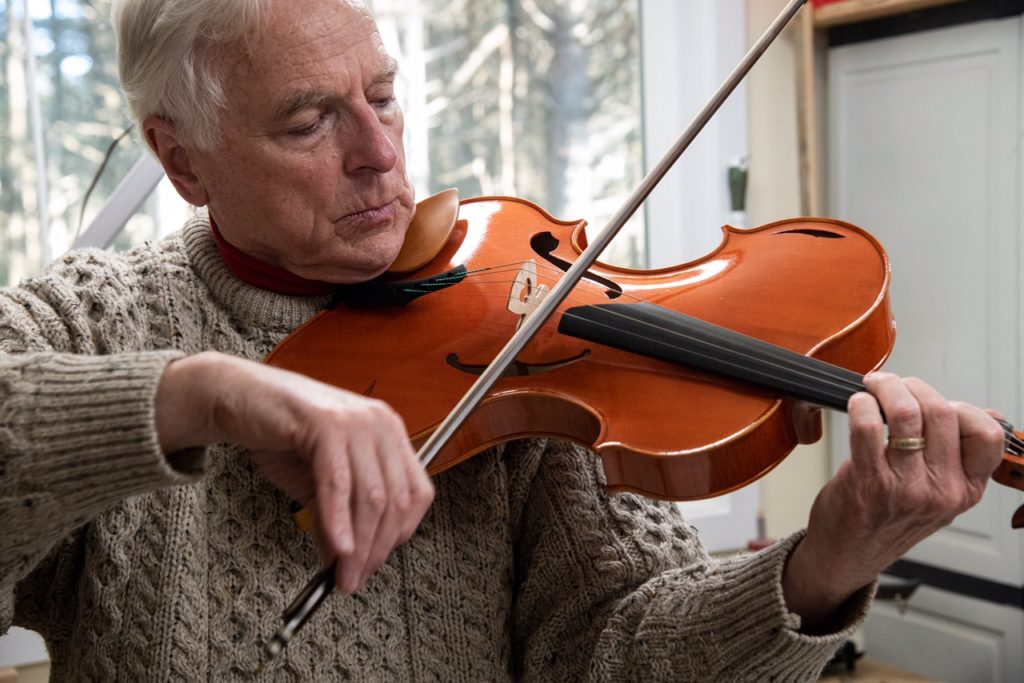
Instrument restorer David Rivinus plays one of the many badly damaged stringed instruments that he has returned to original — or better — condition.

